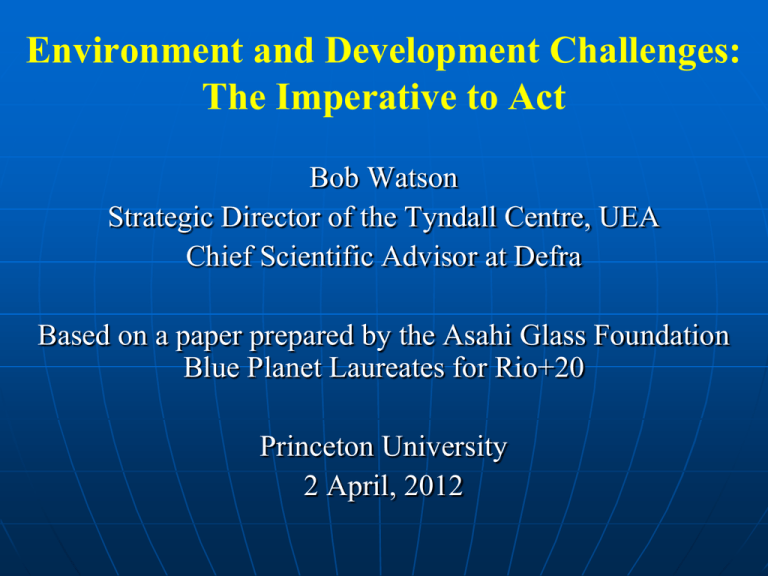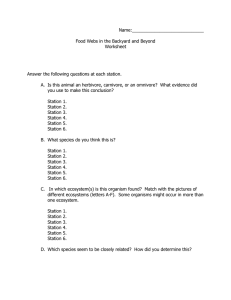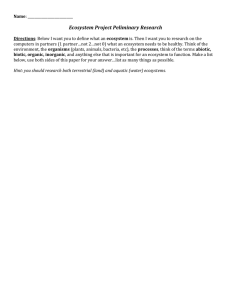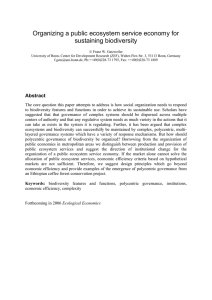Environment and Development Challenges: The Imperative to Act
advertisement

Environment and Development Challenges: The Imperative to Act Bob Watson Strategic Director of the Tyndall Centre, UEA Chief Scientific Advisor at Defra Based on a paper prepared by the Asahi Glass Foundation Blue Planet Laureates for Rio+20 Princeton University 2 April, 2012 Environment and Development Challenges: The Imperative to Act Gro Harlem Brundtland, Paul Ehrlich, Jose Goldemberg, James Hansen, Amory Lovins, Gene Likens, Suki Manabe, Bob May, Hal Mooney, KarlHenrik Robert, Emil Salim, Gordon Sato, Susan Solomon, Nicholas Stern, MS Swaminathan, Bob Watson Barefoot College, Conservation International, International institute for Environment and Development, and International Union for the Conservation of Nature Current Situation • • • • • • Unacceptable levels of poverty and income inequality Unacceptable levels of hunger Lack of access to clean water and energy Significant increases in population Unsustainable economic system Rapid Environmental changes Climate change Loss of biodiversity and ecosystem degradation Land degradation Water pollution Local and regional air pollution The Blue Planet Laureates Dream A world without poverty that is equitable that respects human rights with increased and improved ethical behavior that is environmentally, socially and economically sustainable, where the challenges such as climate change and loss of biodiversity have been successfully addressed This is an achievable dream, but the current system is deeply flawed and our current pathway will not realize it The time to act is now Address population – education of girls, empowerment of women and access to modern forms of contraception Improve resource efficiency – production and use Transition to a low-carbon economy, coupled with adaptation to climate change Address the drivers of biodiversity loss and the degradation of ecosystem services Go beyond GDP – complement with the five forms of capital – built, financial, human, social and natural Eliminate subsidies and create functioning markets to pay for ecosystem services Address failures of governance at the local, national and global level – eliminate the power of vested interests - create systems that are multi-sectoral Scale up grass-roots actions Enhanced levels of education, training, R&D and assessments Population Population projection (Lutz & Samir 2010) 95% 12B 60% 20% 8B 4B 2000 2050 2100 Action needed – education of girls, empowerment of women, health care of children and the elderly, and making modern contraception accessible to all Sustainable Production and Consumption There is an urgent need to break the link between production and consumption on the one hand and environmental destruction on the other This would allow raising material living standards for a period that would allow us to overcome world poverty However, indefinite material growth on a planet with finite and often fragile natural resources will eventually be unsustainable We need to get the economics right – see upcoming slides Climate Change Climate Change The composition of the atmosphere, and the Earth’s climate has changed, mostly due to human activities (highly certain), and is projected to continue to change, globally and regionally: • • • • • • • • Increased greenhouse gases and aerosols Warmer temperatures Changing precipitation patterns – spatially and temporally Higher sea levels – higher storm surges Retreating mountain glaciers Melting of the Greenland ice cap Reduced arctic sea ice More frequent extreme weather events heat waves, floods and droughts • More intense cyclonic events, e,g., hurricanes in the Atlantic The Climate is Warming Surface Temperature Precipitation Projections Dealing with impacts is about managing risk -economic, environmental and social economy Global temperature change (relative to pre-industrial) 0°C 1°C Food 2°C 3°C 4°C 5°C Falling crop yields in many areas, particularly developing regions Falling yields in many Possible rising yields in some developed regions high latitude regions Water Small glaciers disappear – water supplies threatened in several areas Significant decreases in water availability in many areas, including Mediterranean and Southern Africa Sea level rise threatens major cities Ecosystems Extensive Damage to Coral Reefs Extreme Weather Rising number of species face extinction Rising intensity of storms, forest fires, droughts, flooding and heat waves Risk of Abrupt and Major Irreversible Changes Increasing risk of dangerous feedbacks and abrupt, large-scale shifts in the climate system What level of risk are we willing to bear? Stern Review (2006) Transition to a Low-Carbon Economy Universal access to clean energy services is vital for the poor A transition to a low carbon economy will require rapid technological evolution in the efficiency of energy use, environmentally sound low-carbon renewable energy sources and carbon capture and storage The longer we wait to transition to a low carbon economy the more we are locked into a high carbon energy system with consequent environmental damage to ecological and socio-economic systems, including infrastructure Mitigation Strategy Putting a price on carbon through • emissions trading • taxation • regulation - national, regional and global Technology transformation • Carbon capture and storage • Future generation biofuels Mobilising behaviour change • Citizens • Business • Public sector Potential technological options • Efficient production and use of energy: coal plants (e.g., re-powering old inefficient plants and developing IGCC); vehicles (e.g., fuel cell cars) and reduced use of vehicles (e.g., mass transit and urban planning), buildings, and industries • Fuel shift: coal to gas • Renewable Energy and Fuels: Wind power; solar PV and solar thermal; wave and tidal power: small and large-scale hydropower; bio-energy • CO2 Capture and Storage: Capture CO2 in the production of electricity followed by geological storage (e.g., IGCC – CCS) • Nuclear fission: Nuclear power • Forests and Agricultural Soils: Reduced deforestation and degradation; reforestation; afforestation; conservation tillage; reduced fertilizer use Emissions Paths to Stabilization Source: Stern Review Elements of an adaptation strategy Responsibility for development Education and communication Information and good science Risk management plans The eight elements of an adaptation strategy Financing adaptation Linking with other planning processes Legislation and enforcement Support networks Source: Emma Tompkins • Delivery of adaptive responses depends on governance mechanisms • Adaptive capacity and society’s self-organisation is determined by governance • Distribution of costs and benefits in society is determined by governance There limits to adaption: physical, behavioural, technological, financial Physical limits: there are physical limits to potential adaptation on small low lying islands Behavioural limits: there are behavioural constraints that influence where we live and why Technological limits: there are technological limits to the flood defences that can be constructed Biodiversity Loss and Ecosystem Degradation Ecosystem Services ECOSYSTEMS ECOSYSTEM SERVICES Places (e.g: Broad Habitats) where biological, chemical physical interactions The benefits and people get from ecosystems occur. Provisioning Regulating Cultural In terrestrial habitats these include services services services above and below ground processes Crops, Livestock, Game, Fisheries, Water supply, Wild species diversity (genetic resources) Climate, Hazards, Detoxification & Purification, Disease/pest control Pollination Aesthetic, Spiritual, Inspirational, Educational, Recreation, Tourism Wild species diversity Supporting services Necessary for the delivery of other ecosystem services Soil formation, Nutrient cycling, Water cycling, Primary production ECOSYSTEM APPROACH “theland, integrated management of land,organisms water and Air, water, and all living living resources that promotes conservation and sustainable use in an equitable way” Drivers of Biodiversity Loss Indirect drivers Economic Demographic Sociopolitical Cultural & religious Science & Technology Direct drivers Habitat Change Climate Change Invasive Species Overexploitation Biodiversity Loss Nutrients & pollution Unprecedented change: Ecosystems Species extinctions Human activities have taken the planet to the edge of a massive wave of species extinctions, further threatening our own well-being Getting the Economics Right: Beyond GDP Governments should recognize the serious limitations of GDP as a measure of economic activity and complement it with measures of the five forms of capital: built, financial, natural, human and social capital Green taxes and the elimination of environmentallydamaging subsidies in areas such as energy, transportation and agriculture and should be eliminated external environmental and social costs should be internalized market and non-market economic values, and cultural and shared social values, of ecosystem goods and services should be taken into account in decision-making Valuation of goods and ecosystem Other capital People services inputs Primary & intermediate Final ecosystem processes services Crops, livestock, fish Goods Value of goods... …ES value Food £ £ Water availability Primary production Drinking water £ £ Trees Fibre £ £ Decomposition Peat Energy £ £ Wild species diversity Natural medicine £ £ Waste breakdown Pollution control £ £ £ £ £ £ Flood control £ £ Stabilising vegetation Erosion control £ £ Natural enemies Disease control £ £ Meaningful places Good health £ £ £ £ Weathering Soil formation Nutrient cycling Water cycling Detoxification Purified water Climate regulation Pollination Evolutionary processes Ecological interactions Local climate Wild species diversity Equable climate Health and Well-being 26 Food Security Failing to end hunger Undernourishment data versus the MDG Millions target 2007-08 Food price spike Source: Oxfam (2010) Data cited from FAO Hunger Statistics (from 1969 to 2006); Cereal Yield Increases Fisheries Collapse Climate change scenario effects differ (price increase (%), 2010 – 2050, Baseline economy and demography) Minimum and maximum effect from four climate scenarios Page 31 Food security: options to increase production Embed economic, environmental and social sustainability into agricultural policies, practices and technologies Today’s hunger problems can be addressed with appropriate use of current technologies, emphasizing agro-ecological practices (e.g., no/low till, IPM, INRM), coupled with decreased post-harvest losses Small-scale farmers need access to the best seeds, financing and access to markets Advances in S&T are always a needed but cannot be fully utlilzed without rural development, institutional and governance reform Advanced biotechnologies (genomics) may be needed to address future demands for increased productivity and emerging issues such as climate change and new plant and animal pests – but the risks and benefits must be fully understood Access to financing, better seeds, and markets (improved roads0 Food security: options to increase production Provide payments to the farmer for maintaining and enhancing ecosystem services Empower women – gender sensitive extension services, access to financing, property rights Reform international trade, e.g., eliminate OECD production subsidies, eliminate tariff escalation on processed products, recognize the special needs of the least developed countries through non-reciprocal market access Increase public and private sector investment in research and development, and weather and market information Improve public-private-CSO involvement in AKST with accountability for social and environmental outcomes Action on waste and demand Waste in different countries • • • • Determines supply challenge Incentivising the public and private sector Empowering the consumer Need to stimulate the debate on meat Governance, Grass Roots, Education, Training and Knowledge Better Governance is Essential There are serious short-comings in the decision making systems at local, national and global levels The rules and institutions for decision making are influenced by vested interests with an interest in the status quo Effective change in governance demands action to establish transparent means for holding those in power to account • Local level public hearings and social audits to give voice to marginalized groups • National level, parliamentary and press oversight • Globally, we must find better means to agree and implement measures to achieve collective goals Governance failures also occur because decisions are being made in sectoral compartments, with environmental, social and economic dimensions addressed by separate, competing structures Learn from Grass Roots Actions Decision makers should learn from ongoing grass-roots actions and knowledge in areas such as energy, food, water, natural resources, finance and governance This is key, not the least in rural communities with a view to their management, control and ownership of these resources There is a need to scale-up the grass roots actions by bringing together a complementary top-down and bottom-up approach to addressing these issues Global cooperation can be improved by building on ongoing regional cooperation to deal with common sustainable development issues Training, Education, Research and Assessments are Critical Effective training programs for decision makers in business and government to learn how to: • integrate programs and policies within sustainability constraints, and • acquire the skills to strategically move towards such sustainability goals Increase investments in education for all Multi-disciplinary research – “Future Earth Initiative” Assessments of knowledge – need to be coordinated The Time to Act is Now If we are to achieve our dream, the time to act is now, given: The inertia in the socio-economic system The adverse effects of climate change and loss of biodiversity cannot be reversed for centuries or are irreversible (for example, species loss) We know enough to act - we are facing a problem of risk management on an immense scale Failure to act will impoverish current and future generations





